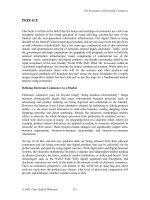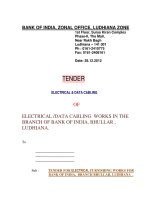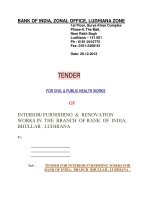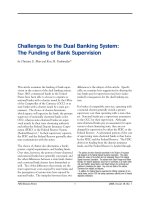marinc & vlahu - the economics of bank bankruptcy law (2012)
Bạn đang xem bản rút gọn của tài liệu. Xem và tải ngay bản đầy đủ của tài liệu tại đây (3.73 MB, 170 trang )
The Economics of Bank Bankruptcy Law
.
Matej Marinc
ˇ
• Razvan Vlahu
The Economics
of Bank Bankruptcy Law
Matej Marinc
ˇ
University of Ljubljana
Faculty of Economics
Department for Money and Finance
Kardeljeva pl. 17
1000 Ljubljana
Slovenia
and
Amsterdam Center for Law & Economics (ACLE)
University of Amsterdam
Roeterstraat 11
1018WB Amsterdam
The Netherlands
Razvan Vlahu
De Nederlandsche Bank
Postbus 98
1000 AB Amsterdam
The Netherlands
ISBN 978-3-642-21806-4 e-ISBN 978-3-642-21807-1
DOI 10.1007/978-3-642-21807-1
Springer Heidelberg Dordrecht London New York
Library of Congress Control Number: 2011937430
# Springer-Verlag Berlin Heidelberg 2012
This work is subject to copyright. All rights are reserved, whether the whole or part of the material is
concerned, specifically the rights of translation, reprinting, reuse of illustrations, recitation, broadcasting,
reproduction on microfilm or in any other way, and storage in data banks. Duplication of this publication
or parts thereof is permitted only under the provisions of the German Copyright Law of September 9, 1965,
in its current version, and permission for use must always be obtained from Springer. Violations are liable
to prosecution under the German Copyright Law.
The use of general descriptive names, registered names, trademarks, etc. in this publication does not imply,
even in the absence of a specific statement, that such names are exempt from the relevant protective laws
and regulations and therefore free for general use.
Printed on acid-free paper
Springer is part of Springer Science+Business Media (www.springer.com)
Preface
This book shows that a special bank bankruptcy regime is desirable for the efficient
restructuring and/or liquidation of distressed banks. We first explore in detail
the principal features of corporate bankruptcy law. Next, we examine specific char-
acteristics of banks includi ng public confidence, negative externalities of bank
failures, opaqueness and the asset substitution problem, and liquidity provision.
These features distinguish banks from other corporations and are largely neglected
in corporate bankruptcy law. Other implications arise from the pressure of multiple
regulators. Finally, we make recommend ations for necessary changes in both
prudential regulation and reorganization policies, which should allow regulators
and banking authorities to better mitigate disruptions in the financial system and
minimize the social costs of bank failures. We support our recommendations with
a discussion of bank failures from the 2007–2009 financial crisis.
Special thanks to Arnoud Boot, Jakob de Haan, Mark Dijkstra, and Timotej Homar. The views
expressed in this book are those of the authors and do not necessarily represent those of the institutions
with which they are affiliated. Vlahu acknowledges financial support from the Gieskes-Strijbis
foundation.
v
.
Contents
1 Introduction 1
2 General Issues in Bankruptcy Law 5
2.1 Coordination Problems . . . 5
2.2 Ex-Ante Efficiency: Incentives in Bankruptcy Law . . . 8
2.3 Bankruptcy Procedures and Their Ex-Post Efficiency . . . 10
2.4 Corporate Bankruptcy Law: Key Features and Implementation . . 16
References 17
3 Are Banks Special? Implications for Bank Bankruptcy Law 21
3.1 What Is Different Abou t Banks? 21
3.1.1 Liquidity Provision and Bank Runs 22
3.1.2 Systemic Impact and Regulatory Failure 23
3.1.3 Ex-Ante Moral Hazard: Risk Shifting 26
3.1.4 Ex-Post Moral Haz ard: Opaqueness and Asset
Substitution 29
3.1.5 Multiple Regulators and Political Economy of Banking . . 30
3.2 Bank Bankruptcy Law . . . . . . . . . . . . . . . . . . . . . . . . . . . . . . . 34
3.2.1 Timely Intervention 34
3.2.2 Ex-Ante and Ex-Post Optimality . 39
3.2.3 Liquidation, Purcha se and Assumption Agreement,
and Nationalization 42
3.2.4 The Design of Bank Bankruptcy Law and Its Relation
to Corporate Bankruptcy Law . . . 49
References 57
4 Systemic Crises 65
4.1 Theoretical Research on Systemic Crises . . . . . . . . . . . . . . . . . . 65
4.2 Empirical Research on Systemic Crises . . . 71
4.2.1 Accommodative Approach Towards Resolving
Systemic Crises . . . . . . . . . . . . . . . . . . . . . . . . . . . . . . . 71
vii
4.2.2 Institutional Environment and the Costs
of Systemic Crises . . . . . . . . . . . . . . . . . . . . . . . . . . . . . 74
4.2.3 The Interaction Between Banking Crises, Currency
Crises, and Sovereign Defaults 76
4.2.4 Overview of Interventions During the 2007–2009
Financial Crisis . . . 77
References 82
5 General Issues on the Structure of Banking Industry 85
5.1 Strengthening the Ex-Ante Regulatory Framework:
Prudential Regulation 85
5.2 Separation of Public Infrastructure from the Financial
System 88
5.3 Netting: The Case of Bank Loans 91
5.4 Closeout Netting: The Case of Derivative Contracts 92
References 94
6 Current Bank Bankru ptcy Regimes and Recent Developments 97
6.1 General Overview of Bank Bankruptcy Frameworks
Around the World . . . . . . . . . . . . . . . . . . . . . . . . . . . . . . . . . . 97
6.2 Early Proposals on the Bank Insolvency Legal Framework:
The Case of Sweden . . . . . . . . . . . . . . . . . . . . . . . . . . . . . . . . . 101
6.3 The European Union Bank Bankruptcy and Reorganizatio n
Regime . . . . . . . . . . . . . . . . . . . . . . . . . . . . . . . . . . . . . . . . . . 103
6.4 The Bank Bankruptcy Regime in Germany 109
6.5 The U.S. Bank Bankruptcy Regime . . 113
6.6 The Dodd-Frank Wall Street Reform and Consumer
Protection Act 116
6.7 Bank Bankruptcy Regime in the UK . . . . . . . . . . . . . . . . . . . . . 121
6.8 Brief Comparison of U.S., UK, and German Bank
Bankruptcy Law and Assessment 124
References 129
7 Optimal Design of Bank Bankruptcy Law and the Bank Failures
from the 2007–2009 Financial Crisis 133
7.1 Optimal Design of Bank Bankruptcy Law . . 133
7.2 The Northern Rock Collapse . . . 139
7.3 The Lehman Brothers Bankruptcy . . 141
7.4 The Fortis Bank Bankruptcy . . . . . . . . . . . . . . . . . . . . . . . . . . . 143
References 145
8 Conclusions 147
viii Contents
9 Appendix 149
9.1 Design of Bankruptcy Law: U.S. Corporate Bankrup tcy Law . . . 149
9.1.1 Liquidation Under Chapter 7 Versus Continuation
Under Chapter 11 . . . . . . . . . . . . . . . . . . . . . . . . . . . . . 149
9.1.2 The Evolution of Chapter 11: DIP Finan cing,
Asset Sales, and Tax Claims . . . . . . . . . . . . . . . . . . . . . 151
9.1.3 Coordination Problems in U.S. Corporate
Bankruptcy Law . . . 153
9.2 Proposed Reforms of U.S. Corporate Bankruptcy Law . . . 153
9.2.1 Shift of Control 154
9.2.2 Asset Sales . . . . . . . . . . . . . . . . . . . . . . . . . . . . . . . . . . 155
9.3 Summary and Compari son Between U.S. Corporate
and Bank Bankruptcy Laws 157
References 157
Contents ix
.
List of Figures
Fig. 4.1 The difference between financial crises with low fiscal costs and
ones with high fiscal costs 73
Fig. 4.2 The difference between financial crises with low output loss
and ones with high output loss 73
Fig. 4.3 The impact of government ownership on the characteristics
of financial crises 75
Fig. 4.4 Intervention policies in the case of (or absence of) currency crisis 77
Fig. 4.5 Forms of interventions and government support during the
2007–2009 financial crisis 78
Fig. 4.6 Bank failures and government assistance 79
Fig. 4.7 Frequency of various intervention methods in the U.S.
(from January 2001 to November 2010) 80
Fig. 4.8 Decomposition of various intervention methods in the U.S. in
terms of asset size of failed banks 80
Fig. 6.1 Frequency of various restructuring methods in 2008 and 2003
(in terms of numbers and asse ts) 98
Fig. 6.2 Restructuring powers of various regulatory bodies (averages;
no ¼ 0, yes ¼ 1) 100
Fig. 6.3 The European system of financial supervisors 107
xi
.
List of Tables
Table 2.1 Objectives of corporate bankruptcy law 15
Table 3.1 What makes banks special? 35
Table 3.2 How debtor-friendly bank bankruptcy law should
be in comparison to corporate bankruptcy law 43
Table 3.3 Advantages and drawbacks of various modes
of bank resolution 48
Table 3.4 Comparison of the design of bank and corporate
bankruptcy law 56
Table 3.5 Effectiveness of various attributes of bank bankruptc y law 57
Table 4.1 Optimal restructuring in a systemic crisis 81
Table 6.1 Characteristics of an average bank bankruptcy framework
around the world (averages across countries,
no ¼ 0, yes ¼ 1) 99
Table 6.2 Comparison of U.S., UK, and German bank
bankruptcy laws 125
Table 9.1 Comparison of U.S. corporate and bank bankruptcy law
for systematically unimportant banks, and the Dodd-
Frank Act’s provisions for bankruptcy of systematically
important financial institutio ns 156
xiii
.
Chapter 1
Introduction
The 2007–2009 financial crisis has shown that bank failures are a common threat in
both developed and emerging economies. Hundreds of lenders have failed since the
onset of the crisis. One lesson from the recent financial turmoil is the need for more
effective systemic regulation. In addition to improvements in the current prudential
and regulatory measures that should allow regulators to identify risks at an early
stage and prevent them from threatening the entire financial system, there is an
increased demand at the national and international level for a specific bank bank-
ruptcy law. This special regime for dealing with troubled banks should create
appropriate tools for prompt intervention in the case of bank distress that would
allow for efficient reorganization and closure of these institutions in order to limit
their impact and protect the safety of the system. Since the onset of the financial
crisis, it has become evident that the legal frameworks for resolving troubled banks
vary widely across countries. This lack of uniformity between resolution regimes
(and, in many instances, the total absence of such regimes) has proved inadequate
when dealing with large distressed specialized and/or universal financial institu-
tions, particularly when they had foreign branches and subsidiaries. The immediate
consequence has been a disorderly intervention by financial authorities in many
countries, which required immense liquidity support for financial institutions and
asset guarantees worth several trillion dollars in total.
The objective of this book is twofold. First, it provides a literature review on
corporate bankruptcy law, characteristics of banks, systemic crisis, and bank bank-
ruptcy regimes. Second, the book gives recommendations for optimal design of
a bank bankruptcy law and emphasizes the differences between the existing corpo-
rate bankruptcy law and a special bank bankruptcy regime. The first step in
discussing optimal bank restructuring policies and cross-country bank insolvency
regimes is to focus on general corporate bankruptcy law. We show that, even
though the objectives and economic principles driving the management of corpo-
rate distress are well defined and an optimal design for reorganizing and liquidating
commercial companies is in place, corporate bankruptcy law largely neglects some
distinctive characteristic of banks. Subsequently, we review those features that
distinguish banks from other corporations. We acknow ledge the special role played
M. Marinc
ˇ
and R. Vlahu, The Economics of Bank Bankruptcy Law,
DOI 10.1007/978-3-642-21807-1_1,
#
Springer-Verlag Berlin Heidelberg 2012
1
by banks in a country’s economy and describe their main functions: (1) liquidity
and payment services provision, (2) asset substitution, and (3) screening and
monitoring of borrowers. Consequently, we explore how the distinctive features
of banks create the need for a special bank resolution regime.
Public confidence is crucial for the banking sector. Once trust in the financial
sector is lost, banks can be subject to runs, which affect not only an individual bank
but may lead to panics and spread through the entire banking sector with reper-
cussions for the economy at large. Negative spillover effects from a bank failure
to other banks in the system spread to the real economy through, for example,
credit rationing for small enterprises or disruption of the payment system, and can
even create a currency crisis and sovereign defaults. The enormous social costs call
for regulatory intervention. In particular, there is a strong demand for a special
resolution regime that is effective in restoring public confidence and stabilizing
the system.
As evidence from the 2007–2009 financial crisis and from previous banking
crises has shown, the authorities have usually chosen between two actions in the
absence of adequate resolution regimes for dealing with insolvent financial
institutions. They have either applied a general insolvency procedure (when dealing
with individual bank failures), or they have recapitalized troubled banks by using
public funds (when the failing banks were considered to have a systemic impact).
Both actions proved to be very costly on the one hand, and to have undesired
collateral effects on the other hand.
A general insolvency regime is ill-suited to deal with bank insolvency because
it is more concerned with value maximization for bank claimants, thus ignoring the
systemic stability of the banking system. This can have dire consequences for the
financial system at large, as Lehman Brothers’ collapse in 2008 has shown.
Relying purely on public funds is not a proper panacea for failing banks either.
Generous public support for failing banks can create an ex-ante moral hazard and
can give banks incentives to take more risk when the financial system functions
normally. When offered unconditionally (e.g., without any restrictions on manage-
ment compensation schemes or replaceme nt of existing management, or without
limitations on bank activities), liquidity injections from banking authorities or asset
guarantees have the perverse effect of subsidizing creditors at taxpayers’ expense,
with a huge cost to the government budget,
1
while eliminating market discipline
and allowing illiquid (and even insolvent) banks to compete with well-capitalized
and well-managed banks. We argue that the special resolution regime for banks
should allow banking authorities to wind down systematically important players in
an orderly way. Different resolution tools should be available to deal with both an
individual bank failure and, more importantly, a systemic failure.
The 2007–2009 financial crisis has refuted the naive thinking that prudential
regulation of banks may prevent bank failures and negative externalities associated
1
See the AIG (American International Group) bailout by U.S. banking authorities in September
2008.
2 1 Introduction
with them. Some of the regulatory rules implemented by banking supervisors (i.e.,
deposit insurance and implicit government guarantees) may even exacerbate banks’
risk-taking incentives and increase the likelihood of distress. We emphasize that
an optimal bank resolution regime should complement prudential regulation and
supervision. More market discipline is desirable for reducing banks’ incentives for
excessive risk-taking. This can be realized both ex-ante by minimizing the coverage
of deposit insurance and ex-post by imposing losses on uninsured creditors when
resolving troubled banks.
Finally, banks’ activities are often supervised by several regulators with differ-
ent individual objectives. Coordination among them is difficult, particularly in
times of distress and in the presence of political pressure. The coordination failure
between domestic regulators can be mitigated by imposing information-sharing
agreements and supervisory cooperation during the pre-insolvency phase, as well as
by creating clear triggers for the bank insolvency regime and shared responsibilities
during the resolution process. The resolution process nevertheless becomes more
complicated when failure threatens a large cross-border bank with subsidiaries
spread across different national jurisdictions. National authorities would have
a strong incentive to protect domestic creditors, and various insolvency regimes
may not be synchronized across countries. Hence, optimal bankruptcy law needs to
consider the cross-border implications of bank failure under the current fragmented
legal framework.
We show that these special features of banks are typically not taken into account
in corporate bankruptcy, and we argue that this makes corporate bankruptcy law ill-
suited for resolving bank bankruptcies. We also make policy recommendations with
respect to the special rules needed for resolving troubled banks. Our recommen-
dations are centered on four main themes: (1) ex-ante optimal regulation, (2) timely
intervention by the regulator, (3) ex-post optimal resolution of distressed banks, and
(4) the need for international coordination to create a uniform resolution regime for
banks in distress.
While establishing a specific resolutio n regime for banks, one should first
address those regulatory features that may increase the likelihood of distress and
ex-ante moral hazard. One way to ensure the mitigation of these problems is the
introduction of procyclical capital ratios. Banks should be required to hold more
capital in good times. This limits the share of risky assets in the bank balance sheet
during upturns and reduces the likelihood of distress in downturns, and the
accumulated cushion allows banks to run normal activities during recessions,
when access to funding is more difficult. Another way is to increase the importance
of market discipline. Finally, transparent quantitative ratios should be used when
estimating the risk of bank distress, and the reliance on credit-rating agencies’ input
should be reduced and their activities regulated.
Timely intervention by the regulator is crucial for mitigating the negative effects
of bank bankruptcy. A pre-insolvency intervention can address financial weak-
nesses at an early stage. Intervention should consist of a set of recommendations
to correct the problem identified by the regulator, a request for raising fresh capital,
and restrictions of activities. To ensure the succe ss of pre-insolvency interv ention,
1 Introduction 3
it is critical to set a clear trigger for this intervention in a transparent way and above
the insolvency and (long-term) illiquidity. If the bank fails to take corrective
actions, the regulator should impose more rigorous sanctions. Financial authorities
should be able to take rapid actions, without the approval of a bankruptcy court, or
the consent of shareholders or creditors.
The objectives of an ex-post resolution for distressed banks differ substantially
from those of corporate bankruptcy. Whereas containing the negative externalities
of bank failure is the main concern for bank bankruptcy regimes, in corporate
bankruptcy the main objective is to maximiz e the total value of the firm. An optimal
resolution mechanism should allow for effective tools to deal with failing banks.
This set of tools should include (1) selling assets (entirely to a private-sector
purchaser or in parts), (2) partial or total transfer of assets and liabilities to a new
entity (i.e., a good bank–bad bank scheme or a bridge bank tool), (3) temporary
public control, and (4) capital injection.
An international agreement for the resolution of multinational (i.e., cross-border)
banks is also necessary. We acknowledge that the establishment of such an agree-
ment is challenging and needs adequate time to be implemented due to various
particularities of bank bankruptcy regimes across countries. Nevertheless, once
accomplished it will assure the convergence of national insolvency regimes and it
will elimina te the disputes between domestic regulators regarding national interest
and sovereignty. The optim al agreement should provide equal treatment to the
creditors of a multinational bank regardless of their location and should contain
an effective mechanism for sharing losses, supervisory duties, and responsibilities
between national authorities during the resolution process.
As set out in detail above, an effective resolution process for banks, given their
distinct features, is needed. It should allow regulators and banking authorities to
quickly mitigate disruptions in the financial system and to minimize the social costs
associated with bank failures. The specific bank insolvency procedure should con-
sider othe r objectives than maximization of value, with the most important being
the containment of systemic risk, the promotion of market discipline, and the miti-
gation of moral hazard.
This book is organized as follows. In Chapter 2, we present the principal
elements of corporate bankruptcy law. In Chapter 3 we discuss the main charac-
teristics of banks that differentiate them from non-financial corpo rations, and we
explain what these characteristics entail for the bankruptcy process involving
banks. Chapter 4 reviews the theoretical and empirical literature on systemic crises,
and Chapter 5 explores general issues related with the optimal bank restructuring
policies. Chapter 6 presents the legal frameworks and resolution regimes for
bank insolvency in various countries. Chapter 7 explores recommendations for
the necessary changes in both prudential regulation and reorganization and closure
policies and pres ents recommendations alongside real banking crisis cases from the
2007–2009 financial crisis. Finally, Chapter 8 contains the book’s conclusions.
4 1 Introduction
Chapter 2
General Issues in Bankruptcy Law
The primary aim of this book is to understand bank bankruptcy law and to make
suggestions on how to improve its design. In order to be able to do this, one first
needs to understand the principles behind the general bankruptcy law.
1
We first synthesize various rationales for the existence of general bankruptcy
law given in the economic literature. Bankruptcy law needs to satisfy divergent
objectives. It needs to prevent coordination problems among creditors. It also needs
to promote efficiency in the relationship between a debtor and creditor in the ex-
ante sense, when the debtor is solvent, and in the ex-post sense, when the debtor is
already insolvent.
2
2.1 Coordination Problems
The need for bankruptcy law is most evident in the case of a corporation borrowing
from several creditors. Without bankruptcy law in place, coordination problems
between creditors may trigger bankruptcy prematurely (Jackson 1986). Even upon a
slight perceived problem with a corporation, each creditor may try to be on the safe
side and sue the corporation first in order to be repaid before other creditors.
Creditors would then race to collect their debt in a behavior similar to a run on a
bank. Secured creditors could cash in the collateral. Short-term creditors could
decide not to roll over their loans. This would force the premature liq uidation of a
corporation that may be wor th more as a going concern.
1
Encyclopedia Britannica defines bankruptcy as “Status of a debtor who has been declared by
judicial process to be unable to pay his or her debts.” However, the question is why such a status of
bankruptcy is needed in the first place.
2
We focus here on corporate bankruptcy law. See White ( 2005) for a comparison of corporate and
personal bankruptcy law.
M. Marinc
ˇ
and R. Vlahu, The Economics of Bank Bankruptcy Law,
DOI 10.1007/978-3-642-21807-1_2,
#
Springer-Verlag Berlin Heidelberg 2012
5
Bankruptcy law aims to mitigate this coordination problem. A common mecha-
nism in most bankruptcy laws is to impose a legal stay (also called an automatic
stay) in which debt repayment in bankruptcy is frozen. Creditors with equal debt
contracts are given equal standing in bankruptcy. Early collection of debt no longer
puts them in front of other creditors. This mitigates the race to collect debts. It gives
the corporation close to insolvency more breathing space and can prevent its
premature liquidation (Hotchkiss et al. 2008; von Thadden et al. 2010).
Although bankruptcy aims to mitigate coordination problems due to multiple
creditors, the question is why corporations borrow from multiple creditors in the
first place. Financing from multiple creditors and the threat of early collection is
beneficial because it exerts additional pressure on the debtor. A debtor in a good
financial state, know ing that renegotiation in an adverse situation is difficult,
restrains from excessive risk-taking, exerts sufficient effort, and has no incentives
to strategically default on his debt repayment (Bolton and Scharfstein 1996). A
multitude of creditors also have lower incentives to engage in rent-seeking
activities (Bris and Welch 2005).
However, having multiple creditors may create inefficiencies. In particular,
financing from multiple creditors can lead to duplicated monitoring of creditors
(Winton 1995). Creditors will free ride on monitoring the debtor (Bris and Welch
2005). Difficult renegotiation between multiple creditors may induce excessive
liquidation even when continuation is optimal and when default is beyond the
debtor’s control (Bolton and Scharfstein 1996). It is the aim of bankruptcy law to
allow for the benefits and at the same time mitigate the drawbacks of having
multiple creditors.
However, this is not an easy task. Bankruptcy law only partially mitigates
coordination problems between creditors. Creditors have means to put themselves
before other creditors despite bankruptcy law. One possibility is to engage in
leapfrogging. That is, a creditor may improve seniority and quality of the collateral
in renegotiat ion of his loan with a debtor. For example, the creditor can condition
rolling over his loan on improvement of his seniority and collateral, thereby
increasing his payout in bankruptcy.
3
The argument against bankruptcy law may also be that a debtor and his creditors
can renegotiate debt contracts on their own through voluntary debt restructuring, for
example.
4
Debt restructuring can be beneficial for debtors and creditors if a
corporation with a viable business has only temporary financial problems but
profitable long-term prospects. However, coordination problems may hinder nego-
tiation between a debtor and multiple creditors. A hold-out problem can occur, in
3
The existing creditors may also try to renew their loan after the bankruptcy has already started
because in most bankruptcy laws this could automatically give them a super-senior status against
all remaining creditors.
4
Institutional lenders can also coordinate on their own in order to prevent coordination problems.
See Brunner and Krahnen (2008) for the case of bank pool formation in distressed lending in
Germany.
6 2 General Issues in Bankruptcy Law
which a small creditor could oppose restructuring of debt and demand overcom-
pensation (Gertner and Scharfstein 1991). Because voluntary debt restructuring
needs the unanimous consent of creditors, even a small creditor may have excessive
power in the negotiation process. Bankruptcy law commonly mitigates the hold-out
problem becau se the corporation in bankruptcy needs less than unanimous support
of the cred itors for restructuring. Bankruptcy proceedings are usually designed to
facilitate negotiations between shareholders and creditors. An important questio n of
optimal design of bankruptcy law is how to set a trigger for bankruptcy.
Optimal bankruptcy trigger: Bankruptcy law aims at setting the optimal timing of
when the corporation would enter bankruptcy and, by doing so, mitigates coordina-
tion problems between creditors. Coordination problems act as countervailing
forces in pushing for bankruptcy. On the one hand, running to collect debt triggers
bankruptcy prematurely. On the other hand, the hold-out problem hinders voluntary
negotiation between the corporation and multiple creditors, and may postpone the
start of bankruptcy proceedings. In this respect, an important ingredient of bank-
ruptcy law is who can trigger bankruptcy and under what conditions.
To mitigate the race to collect debt, creditors should have the power to trigger
bankruptcy. Each creditor can then prevent early collection by other creditors (e.g.,
seizure of collateral by secured creditors) that could lead to premature liquidation.
If the hold-out problem is an issue, a debtor should also have the power to trigger
bankruptcy. In this case, a debtor could, by entering bankruptcy on his own,
override a small creditor that would oppose restructuring. However, the conditions
to exercise a trigger need to be precisely stated, otherwise the debtor would
strategically enter bankruptcy to rid himself of his debt. Usually the firm needs to
be illiquid (i.e., unable to repay debts as they fall due), but in several bankruptcy
laws in addition to illiquidity the corporation needs to be insolvent as well (i.e., the
value of liabilities needs to surpass the value of assets) .
5
Von Thadden et al. (2010) explicitly model the differences between debt collec-
tion and bankruptcy. Each creditor’s right to liquidate assets will protect him
against opportunistic behavi or by the debtor. In contrast, bankruptcy law through
an automatic stay limits the individual rights to liquidate assets. In this setting,
giving the right to trigger bankruptcy to creditors is not always optimal because
creditors would want to foreclose individually if this offers them higher value than
in bankruptcy. In such a case, the debtor should have the power to trigger bank-
ruptcy to defend against an excessive foreclosure (see also Baird 1991).
Going back to the need for bankruptcy law, cannot creditors and debtors mitigate
potential problems on their own by writing detailed contracts that would appropri-
ately contain coordination problems? The incomplete contract theory recognizes
that writing complete contracts (i.e., contracts that are contingent on all future states
of nature) is simply too difficult a task.
6
In this view, the design of bankruptcy law
5
An example is the UK corporate bankruptcy law.
6
In Bolton and Scharfstein (1990) and Hart and Moore (1994) a court cannot precisely verify
which state of nature has occurred; hence, a contract contingent on the states of nature has no legal
value because the court cannot determine the contingent obligations of creditors and debtors.
2.1 Coordination Problems 7
should mitigate inefficiencies that may arise in individual contracting between a
debtor and his creditors.
Importantly, bankruptcy law should not create new inefficiencies. Debtor and
creditors could adjust debt contracts and circumvent unwanted features of bank-
ruptcy law only to a certain extent. Davydenko and Franks (2008) empirically
compare different bankruptcy laws and confirm that creditors adjust debt contracts
to the special features of bankruptcy law, but can only partially mitigate the
suboptimal features of bankruptcy law.
7
Now we analyze how bankruptcy law affects incentives and the behavior of a
debtor and his creditors.
2.2 Ex-Ante Efficiency: Incentives in Bankruptcy Law
The main objective of bankruptcy law in the ex-ante sense is to elicit optimal
incentives and behavior from debtors and their creditors before bankruptcy occurs.
Bankruptcy law should refine the features of debt contracts in bankruptcy to (1)
evoke optimal control of debtors by creditors, (2) give debtors incentives to
undertake optimal risk and supply sufficient effort, and (3) affect optimal timing
of bankruptcy.
Several theoretical contributions specify the benefits of a debt contract for
efficient contracting between a debtor and his creditor. In a standard debt contract,
the creditor is entitled to a fixed payment and the debtor to the residual. However, if
the creditor cannot be repaid, the bankruptcy occurs with the debtor receiving zero
and all the proceeds going to the creditor.
In a costly state verification framework, in which creditors can only audit
debtors’ returns at a cost, Gale and Hellwig (1985) and Townsend (1979) show
that an efficient contract that minimizes auditing costs contains the main features of
a standard debt contract. If a debtor repays the borrowed funds and the interest, the
audit is not necessary and auditing costs are not incurred. However, if a debtor
defaults on loan repayment, the creditor needs to audit the debtor and seize the
debtor’s remaining funds.
In the free cash-flow theory of Jensen (1986), debt serves to pump cash out of the
firm and out of the reach of a manager that would spend it for his own perks, instead
of using it to the best interest of shareholders. In the asymmetric information
framework of Myers ( 1984), debt is less informationally sensitive than equity and
therefore easier and cheaper to raise. In the incomplete contract approach, Hart and
Moore (1998) show that debt contracts are optimal because they allow debtors to
reinvest the most in good states of the world when this is valuable (e.g., when the
7
Davydenko and Franks (2008) show that French banks require more collateral to respond to a
creditor-unfriendly bankruptcy code. However, they show that bank recovery rates remain
remarkably different across countries with different bankruptcy laws.
8 2 General Issues in Bankruptcy Law
economy is booming) and allow creditors to liquidate the projects in bad states of
the world (e.g., in a recession). In addition to the theoretical studies, a brief look at
practice also shows that only a few corporations do not use debt financing at all.
Theoretical literature on optimal debt contracts has implications for the optimal
design of bankruptcy law in the ex-ante sense; that is, at the moment when a debtor
is still solvent. An efficient debt contract entitles the creditor to the debtor’s
remaining funds upon default on a loan repayment. Hence, in the ex-ante sense
optimal bankruptcy law should be creditor-friendly: it should guarantee high
payoffs to creditors in the case of bankruptcy. Only if bankruptcy is considered a
sufficient threat would managers take debt repayment seriously enough and not
expropriate free cash flow from the firm (Jensen 1986) or conceal the true returns of
the firm (Gale and Hellwig 1985; Townsend 1979).
Creditor-friendly bankruptcy law creates appropriate incentives for debtors in
the ex-ante sense . Povel (1999) argues that creditor-friendly bankruptcy law
presents a sufficient threat that underperforming managers would be fired in the
case of bankruptcy, thereby giving incentives to managers to provide sufficient
effort. Bebchuk (2002) shows that debtors take less risk ex-ante if bankruptcy law is
creditor-friendly. His intuition is twofold. First, creditor-friendly bankruptcy law
provides a sufficient penalty in the case of failure, and therefore debt ors are more
careful not to take excessive risk. In addition, if bankruptcy law is creditor-friendly,
creditors anticipate high returns in the case of bankruptcy and demand lower
interest rates. Lower interest rates increase the attractiveness of safe project s and
limit risk-taking. Empirical research shows that corporations take less risk under
creditor-friendly bankruptcy codes.
8
Ex-ante optimal bankruptcy law defines the division of the value of the
bankrupted corporation between the debtor and its creditors that maximizes the
value of the corporation before bankruptcy. In the ex-ante sense, bankruptcy rules
do not serve to protect creditors because creditors can protect themselves even if
bankruptcy law is debtor-friendly: they can charge higher interest rates or have a
stricter lending policy. However, the design of bankruptcy law affects firm value in
an indirect sense through its impact on incentives and behavior of creditors and
debtors. Proper incentives lower the cost of and access to debt financing (see also
Longhofer and Carlstrom 1995).
9
8
However, Acharya et al. (2009) provide evidence that firms more often engage in value-
destroying diversifying acquisitions under creditor-friendly bankruptcy codes. Excessive conser-
vatism spurred by creditor-friendly bankruptcy codes also hinders innovation; see also Acharya
and Subramanian (2009). Berkovitch et al. (1997) show that creditor-friendly bankruptcy law may
allow creditors to appropriate a debtor’s rents and therefore diminish investment into firm-specific
human capital.
9
Longhofer (1997) theoretically shows that creditor-friendly bankruptcy law enhances access to
credit. Empirical evidence is provided by Berkowitz and White (2004). In order to lower the cost
of debt, Cornelli and Felli (1997) show that bankruptcy law needs to move valuable control rights
from the insolvent debtor to creditors before the start of the bankruptcy process. La Porta et al.
2.2 Ex-Ante Efficiency: Incentives in Bankruptcy Law 9
The design of bankruptcy law should set the right incentives to trigger bank-
ruptcy. Bankruptcy law that is creditor-friendly acts as a threat for a debtor not to
strategically defa ult (i.e., to declare bankruptcy to obtain debt relief).
10
However,
when the firm approaches bankruptcy, the need for creditor-friendly bankruptcy law
is diminished. Under creditor-friend ly bankruptcy law, the manager of a failing
corporation will try to postpone bankruptcy to the detriment of creditors
(Berkovitch and Israel 1999). The manager can hide losses through the use of
creative accounting, or simply free cash flows by spending less on R&D and on
product quality. A debtor-friendly bankruptcy law will improve the timing of
bankruptcy. Keeping the manager on board in case of bankruptcy will induce the
manager to declare bankruptcy in a timely manner (Povel 1999).
11
2.3 Bankruptcy Procedures and Their Ex-Post Efficiency
The objectives of bankruptcy law change substantially in the ex-post sense when
the debtor has already entered bankruptcy. Bankruptcy law in the ex-post sense
should maximize the value of assets of the bankrupted firm. Three objectives are
important. Bankruptcy should lead to welfare-increasing asset reallocations. The
costs of bankruptcy due to administrative procedures and lost reputation should be
as low as possi ble and the incentives for the debtor and his creditors should induce
optimal behavior.
Efficient bankruptcy procedures are central for the smooth operation of a market
economy. Corporations usually use bankruptcy to exit the industry and to cease
their operations. Bankruptcy allows competition to drive inefficient corporations
out of business and incapable managers out of their jobs, which raises the average
efficiency of the industry (Melitz 2003; Syverson 2004). Exit from the industry
should be as cheap as possible in order to have high entry and high competition in
the industry. Such reallocations lead to Schum peterian-like “creative destruction”
that may offer welfare gains and benefit consumers.
(1997) show that countries with greater creditor protection have larger and more developed credit
markets; see also Djankov et al. (2007).
10
Even though creditors may protect themselves against strategic defaults, such actions may
increase the cost of debt and lower its availability. Long-term creditors may demand durable
collateral and force the firm to match liabilities with assets (Hart and Moore 1994). In this sense,
creditor-friendly bankruptcy law that mitigates strategic defaults allows for longer maturity of debt
and less collateral.
11
Bisin and Rampini (2006) show that bankruptcy is especially important in an environment
where the main creditor cannot monitor whether the debtor takes on additional debt from other
creditors. They show that debtor-friendly bankruptcy law induces the debtor to declare bankruptcy
in a timely manner. Bankruptcy adds value for the creditor because the court verifies the assets and
liabilities of the debtor, liquidates the assets, and repays the senior creditor (the bank) first.
10 2 General Issues in Bankruptcy Law









